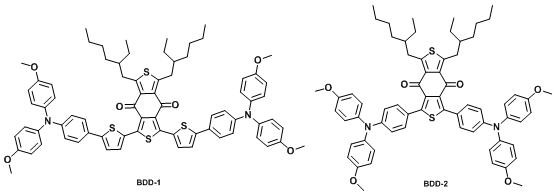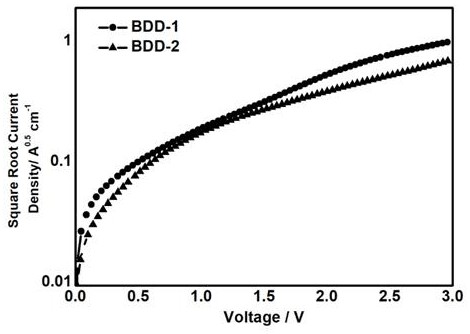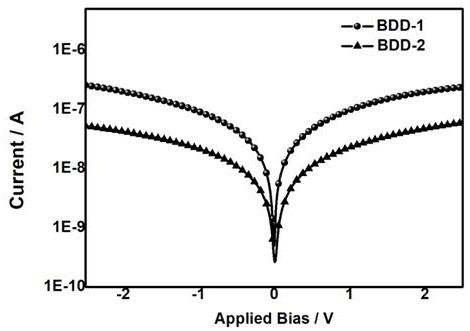Hole transport material taking benzodithiophene diketone as core, synthesis method and application of hole transport material in perovskite solar cell
A technology of benzodithiophenedione and hole transport materials, which is applied in circuits, photovoltaic power generation, electrical components, etc., can solve the problems of complex synthesis and purification steps, increase battery production costs, and reduce battery stability, etc., to achieve excellent photoelectricity Performance and stability, reaction steps and purification are simple and easy to operate, and the effect of reducing production cost
- Summary
- Abstract
- Description
- Claims
- Application Information
AI Technical Summary
Problems solved by technology
Method used
Image
Examples
Embodiment 1
[0037] Synthesis of hole transport material BDD-1 and its application in perovskite solar cells:
[0038]
[0039] In a dry reaction vessel were added compound 1 (0.382 g, 0.5 mmol), 4,4'-dimethoxytriphenylamine-4''-boronic acid pinacol ester (0.474 g, 1.1 mmol), tetrakis(triphenyl Phosphine) palladium (0.057 g, 0.05 mmol), saturated potassium carbonate aqueous solution (10 mL) and solvent tetrahydrofuran (100 mL), stirred evenly under nitrogen protection conditions, and heated to 80 ° C for 16 hours, after the reaction, The reaction solution was cooled to room temperature, and the reaction solution was extracted and separated three times with dichloromethane solution (150 mL). The organic layer was collected, and the solvent was removed under reduced pressure. 1.5:1 vol / vol) as the eluent and dried in vacuum to obtain the yellow solid hole transport material BDD-1 (0.378 g, yield: 62.3%). 1 H NMR (400 MHz, Chloroform- d ) δ 7.79 (d, J = 7.8 Hz, 2H), 7.49 (d, J = 8.7 H...
Embodiment 2
[0043] Synthesis of hole transport material BDD-2 and its application in perovskite solar cells:
[0044]
[0045] Add compound 1 (0.300 g, 0.5 mmol), 4,4'-dimethoxytriphenylamine-4''-boronic acid pinacol ester (0.474 g, 1.1 mmol), tetrakis(triphenyl Phosphine) palladium (0.057 g, 0.05 mmol), saturated potassium carbonate aqueous solution (10 mL) and solvent tetrahydrofuran (100 mL), stirred evenly under nitrogen protection conditions, and heated to 80 ° C for 16 hours, after the reaction, The reaction solution was cooled to room temperature, and the reaction solution was extracted and separated three times with dichloromethane solution (150 mL). The organic layer was collected, and the solvent was removed under reduced pressure. 1.5:1 vol / vol) as the eluent and dried in vacuum to obtain a yellow solid hole transport material BDD-2 (0.337g, yield: 64.2%). 1 H NMR (400 MHz, Chloroform- d ) δ 7.51 – 7.44 (m, 4H), 7.22 – 7.13 (m,8H), 6.95 – 6.85 (m, 12H), 3.87 – 3.80 (m, 12H...
PUM
 Login to View More
Login to View More Abstract
Description
Claims
Application Information
 Login to View More
Login to View More - R&D
- Intellectual Property
- Life Sciences
- Materials
- Tech Scout
- Unparalleled Data Quality
- Higher Quality Content
- 60% Fewer Hallucinations
Browse by: Latest US Patents, China's latest patents, Technical Efficacy Thesaurus, Application Domain, Technology Topic, Popular Technical Reports.
© 2025 PatSnap. All rights reserved.Legal|Privacy policy|Modern Slavery Act Transparency Statement|Sitemap|About US| Contact US: help@patsnap.com



